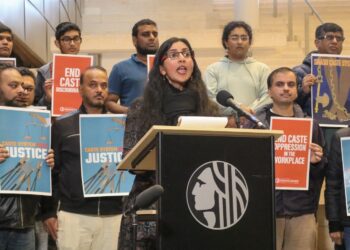On Monday, the United States Embassy in India made an announcement regarding their issuance of a historic number of student visas to Indian scholars this summer season.
As per details furnished by the U.S. Mission in India, an impressive tally of over 90,000 student visas was granted during the months of June, July, and August. These statistics underscore that a remarkable one-quarter of all student visas globally were conferred to applicants in India.
In a statement released on X (formerly Twitter), the US Embassy India conveyed, “The US Mission in India is pleased to announce that we issued a record number – over 90,000 – of student visas this Summer/ in June, July, and August. This summer almost one in four student visas worldwide was issued right here in India!”
The post extends its warm congratulations and best wishes to the students who have made the United States their preferred destination for pursuing higher education. It reads, “Congratulations and best wishes to all the students who have chosen the United States to make their higher education goals a reality! That’s a wrap! With teamwork and innovation, we ensured that all qualified applicants reached their programs on time.”
In the previous year, a remarkable 125,000 student visas were granted to Indian nationals, surpassing all other countries in terms of visa issuance. As of 2023, there are approximately 200,000 Indian students enrolled in academic institutions across the United States, constituting over 20 percent of the current international student population in the country.
According to official data released by the Government of India last year, in 2022, there were approximately 4,65,791 students residing in the United States on study visas.
The Open Doors Report 2022, unveiled on November 15, had highlighted that India’s portion of the overall international student population had surged from 11.8 percent to 21 percent. As a result, India had surpassed China in terms of the number of international students studying in the United States.
In 2022, the total count of international students pursuing higher education in the United States increased from 9.14 lakhs in 2020-21 to 9.48 lakhs in 2021-22.
The Open Doors Report 2022 also revealed that nearly half of Indian students pursuing higher education in the United States were distributed across six American states: New York, California, Texas, Illinois, Massachusetts, and Arizona, which are home to 12 higher educational institutions ranked within the top 100 in the latest QS rankings.
Remarkably, aside from engineering, programs in mathematics and computer sciences have taken the lead in terms of popularity over the past decade. Additionally, an analysis by The Indian Express of Open Doors data compiled by the US State Department and the non-profit Institute of International Education (IEE) indicated a growing trend among Indian students in the United States opting to stay in the country after completing their degrees, often joining three-year work or training programs.
In an earlier report published by Mint in June, it was highlighted that the United States had initiated the visa appointment process for F1 student visas across its consulates in India. These appointments were made available from mid-July to mid-August.
Furthermore, study abroad consultants, as reported by the Economic Times, had revealed that a significantly larger number of Indian students were embarking on overseas studies this autumn compared to previous years. This surge can be attributed to several factors, including heightened aspirations for foreign education and career prospects, along with a notable increase in applications from Tier 2 and Tier 3 cities, according to the report.
Commenting on the influx of Indian students enrolling in US institutions this fall, Piyush Kumar, the Regional Director for South Asia and Mauritius at IDP Education, conveyed to ET, “This year has been remarkable. The numbers have increased, possibly exceeding those of the pre-pandemic year. Approximately 25-30 percent of US enrollments have originated from Tier 2/3 cities.”











